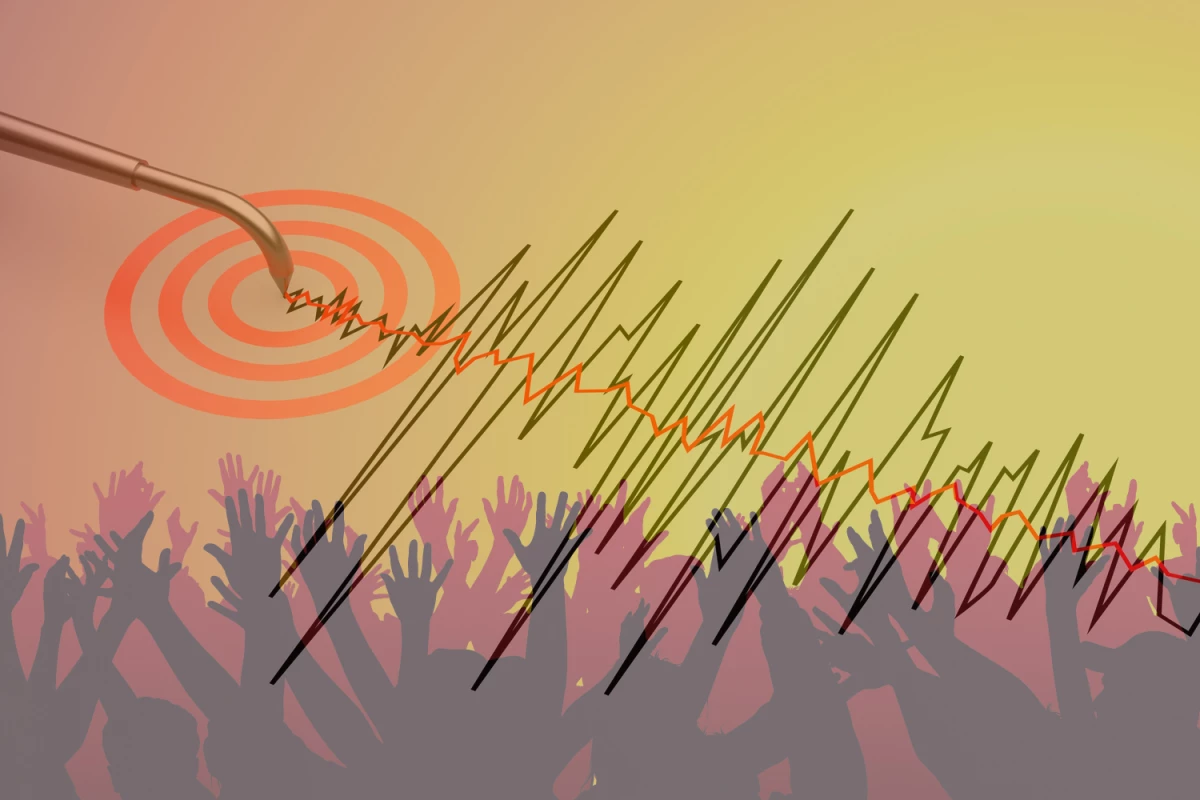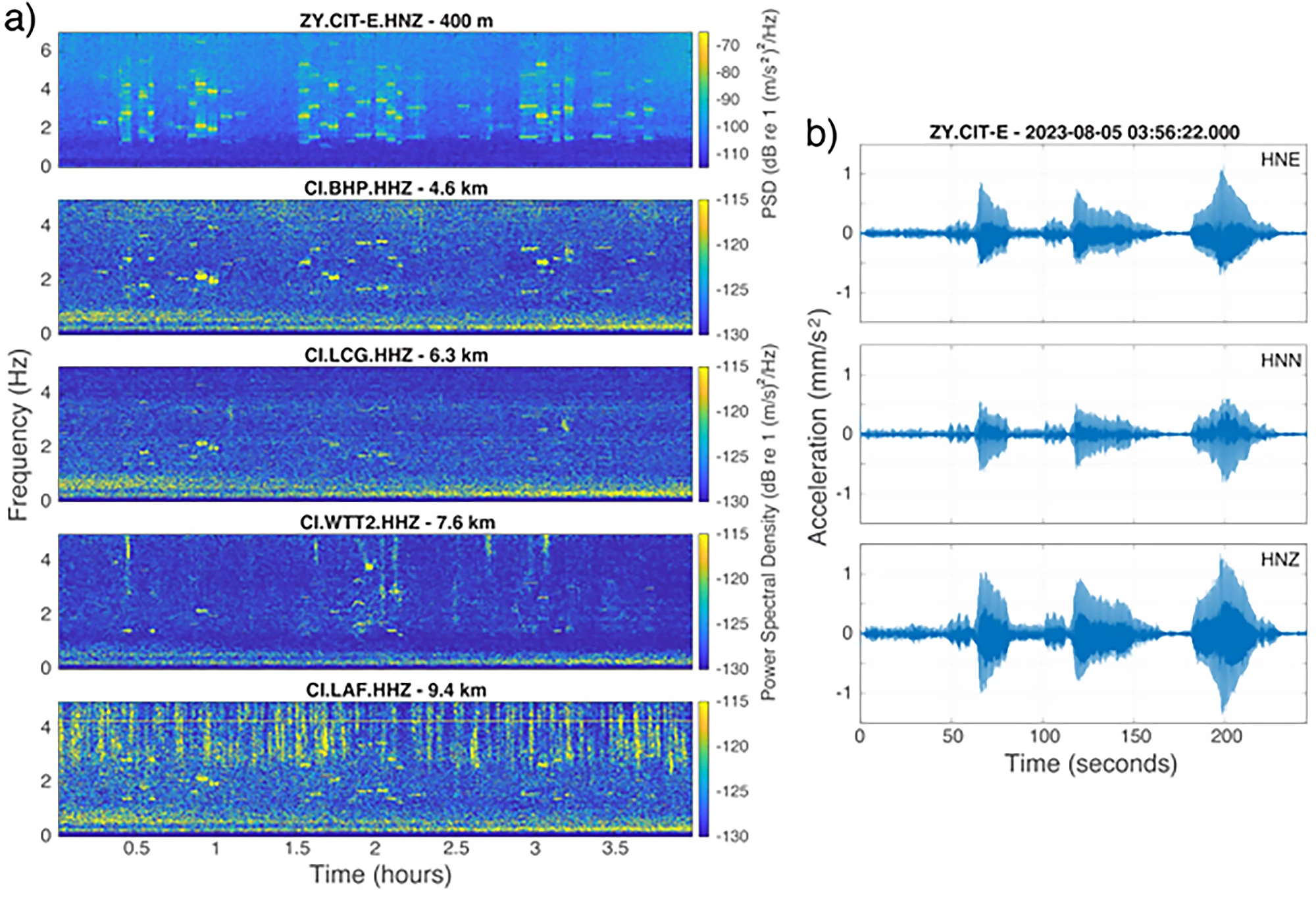Taylor Swift fans have been linked to some well-reported seismic activity during her current worldwide 'Eras' concert tour. With none other than the Seismological Society of America, which has been researching earthquakes since the Great San Francisco Earthquake of 1906, publishing a new study analyzing the degree of tremor a T-Swift concert generates, we thought we’d investigate how other musical artists' fans stacked up in terms of their stadium-shaking abilities.“Swift Quake” – Lumen Field, Seattle, US, July 22, 2023
It was the event that kicked off a media frenzy. Performing her ‘Eras’ concert at Seattle’s Lumen Field on July 22, a stadium-record 72,171 enthusiastic Swifties caused seismic activity equivalent to a 2.3-magnitude earthquake, according to Jackie Caplan-Auerbach, a seismologist and geology professor at Western Washington University who spoke with CNN at the time.

The “Swift Quake” – as it’s become known – was immediately compared to “Beast Quake,” a 2011 event at the same venue where, following an impressive touchdown by NFL running back Marshawn ‘Beast Mode’ Lynch, Seattle Seahawks fans erupted. Sports and music fans alike wanted to know which event produced the most tremor.
Thankfully, both had been recorded on the same seismological equipment, so Caplan-Auerbach set to work comparing the two. She found that Swifties had Seahawks fans well-and-truly beat, producing twice the amount of ground shake.
“Scott Quake” – The Circus Maximus, Rome, Italy, August 7, 2023
Two weeks after the “Swift Quake,” late at night on August 7, hundreds of alarmed locals in Rome, Italy, called the fire department to report an earthquake. Only it wasn’t. It was a “Scott Quake”.

Jacques Bermon Webster II, better known as rapper, singer-songwriter and record producer Travis Scott, was performing his ‘Utopia – Circus Maximus’ tour at the actual (and ancient) Circus Maximus to a crowd of 60,000 ‘Ragers,’ the name given to his fans. When special guest Kanye West joined Scott on stage, the resulting “Scott Quake” registered the equivalent of a 1.3-magnitude earthquake, according to some back-of-the-envelope calculations done by Giovanni Diaferia, a geophysics researcher who analyzed the seismic recording of the concert and shared his findings on X (formerly Twitter).
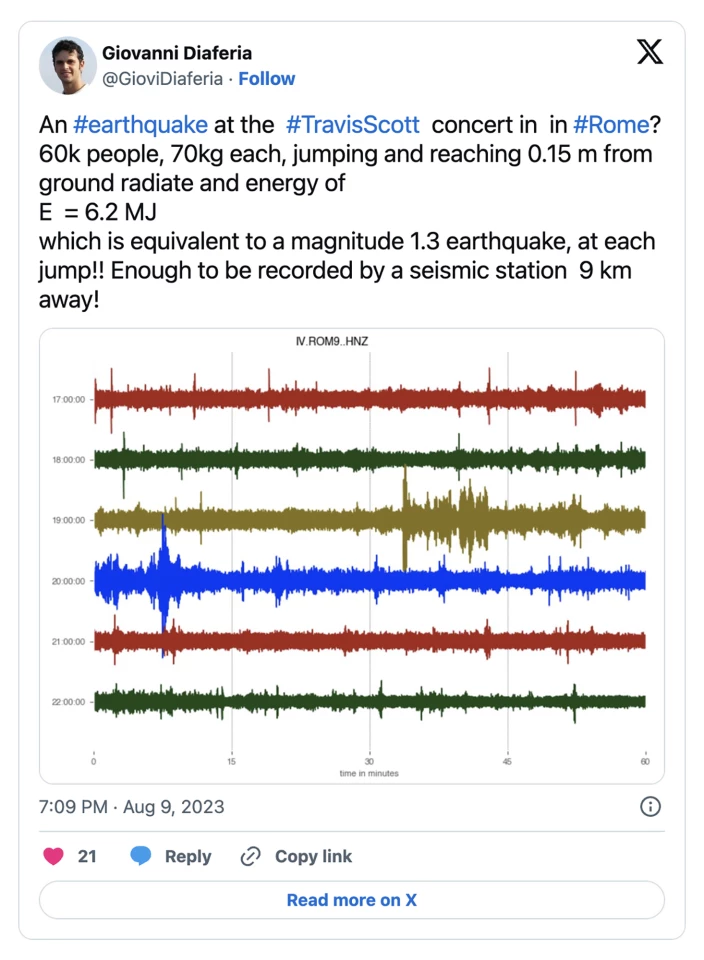
But Scott had more to contend with than concerned callers. Roman archeologists were angry that his Ragers might’ve damaged the archaic chariot-racing stadium he was playing in. The Circus Maximus, which dates back to the 6th century BCE, was the first and largest stadium built in Ancient Rome and was later extended by Julius Caesar. While the stadium has hosted (arguably) tamer artists before Scott, such as Imagine Dragons and Bruce Springsteen, since the “Scott Quake,” Alfonsina Russo, director of the Colosseum Archeological Park, has called for an end to concerts at the site.
“Garthquake” – Tiger Stadium, Louisiana, April 30, 2022
Country singer Garth Brooks’ version of the song “Callin’ Baton Rouge” has become the unofficial anthem of Tiger Stadium, better known as Death Valley, situated on the Louisiana State University (LSU) campus, which is, of course, in Baton Rouge. So, playing the song for the first time to more than 102,000 fans on April 30, they understandably went nuts.
The audience erupted with a heartfelt cheer when the opening fiddle strains of the song pealed out of the stadium’s speakers at around 9:30pm. They sang along with Brooks, providing additional accompaniment by stomping boots and clapping hands. Nearby, at LSU’s Nicholson Hall, a seismograph recorded the vibrations that were created.
The performance was so loud, reaching above 95 decibels, that it set off noise warnings on attendees’ smart devices. And, while neither the media nor anybody else has mentioned the actual magnitude of the “Garthquake,” an image of LSU’s seismic recording did the rounds on X/Twitter.
An LSU professor set up a seismograph machine tonight for the @garthbrooks concert in Baton Rouge.
— Cody Worsham (@CodyWorsham) May 1, 2022
Here's a snapshot of what it looked like when he played Callin' Baton Rouge.https://t.co/uuqI74fBak pic.twitter.com/ThjfEJ4q0y
It’s the second time cheering Death Valley fans have triggered an LSU seismograph. The first was on October 8, 1988, during a college football game between LSU and rivals Auburn University. Auburn was leading LSU 6–0 with less than two minutes left in the game when LSU quarterback Tommy Hodson threw an 11-yard touchdown pass to Eddie Fuller. The crowd’s reaction to the pass was discovered on the seismograph the following morning and reported to the media, who dubbed it the “Earthquake Game." The name stuck.“Boss Quake” – Camp Nou, Barcelona, Spain, May 14, 2016
Tremors caused by a four-hour show by Bruce 'The Boss' Springsteen and The E Street Band at Barcelona’s Camp Nou stadium in May 2016, attended by 65,000 people, caught the attention of Jordi Díaz, scientific director of the Seismic Laboratory at the Institute of Earth Science Jaume Almera (ICTJA).
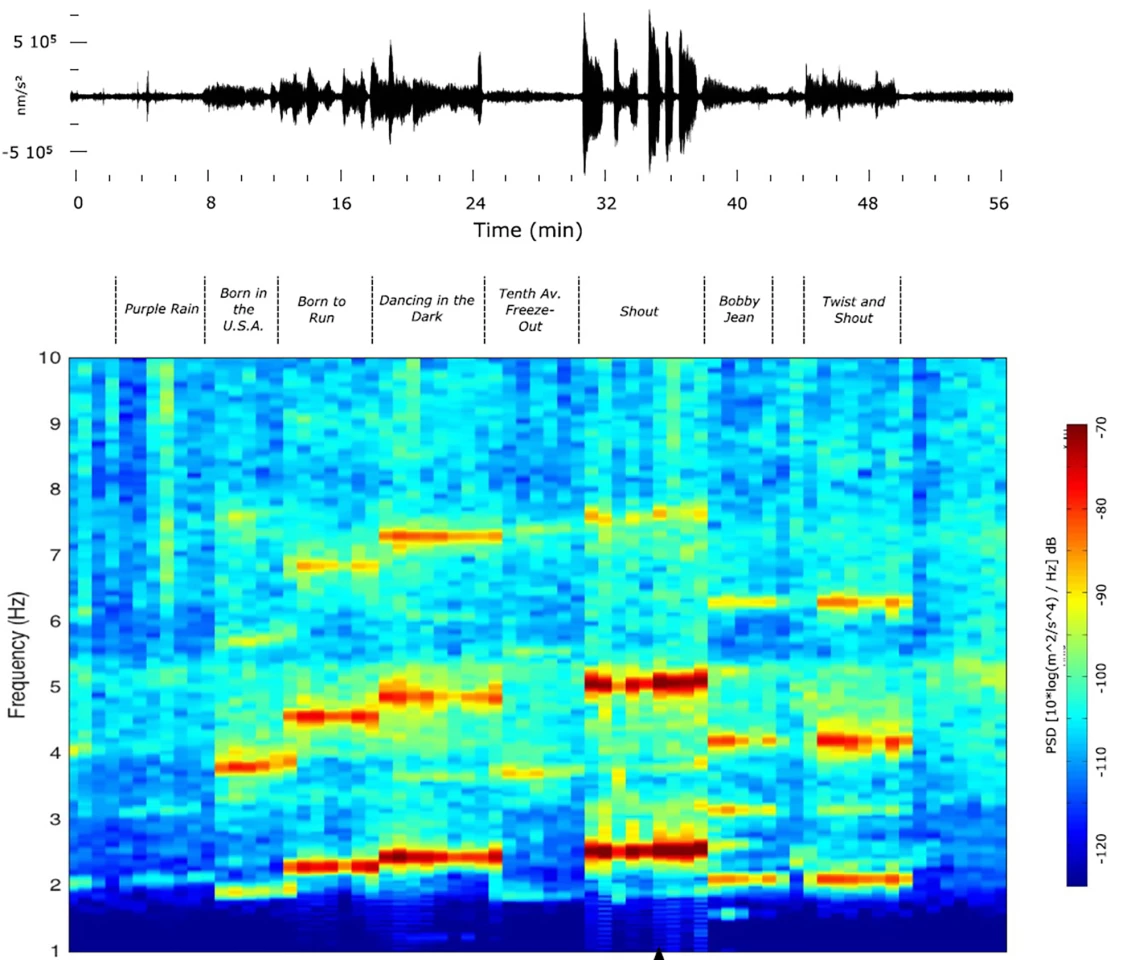
The broadband seismometer that recorded fans' coordinated jumping during Springsteen’s songs showed that seismic amplitudes strongly increased during the encores without a corresponding increase in the band’s sound volume. Amplitude was particularly high during the song “Shout." Díaz and his colleagues’ seismic findings were published in Scientific Reports.
“Akker Dakker Quake” – Western Springs Stadium, Auckland, New Zealand, December 15, 2015
Aussie rockers AC/DC are renowned for being one of the loudest bands on the planet. When the band played the Western Springs Stadium in Auckland on the 15th of December 2015 as part of their ‘Rock or Bust’ world tour, the concert was so loud – 103 decibels – that it was heard four miles (6.4 km) away and registered on seismographs a couple of kilometers away. Falling just shy of the council-permitted maximum noise level of 107 decibels meant the concert didn’t breach any noise regulations.

While no magnitude was assigned to the seismic activity generated by Akker Dakker’s Auckland gig, the Institute of Geological and Nuclear Sciences of New Zealand – GeoNet, which provides public access to earthquake reports, did post seismograph readings from the concert on its blog. In a disappointing blow for AC/DC fans everywhere, they were beaten by the Foo Fighters, whose fans created much more ground vibration during their 2011 concert (see below).
“Foo Quake” – Western Springs Stadium, Auckland, NZ, December 13, 2011
Maybe it’s just what happens when bands play Western Springs, but according to GeoNet’s blog, when hard-rockers the Foo Fighters played to a 50,000-strong crowd at the Auckland stadium in December 2011, two nearby seismic stations recorded vibrations with a peak oscillation of three Hz that coincided with when the support band, Tenacious D, started playing and stopped when the concert did.
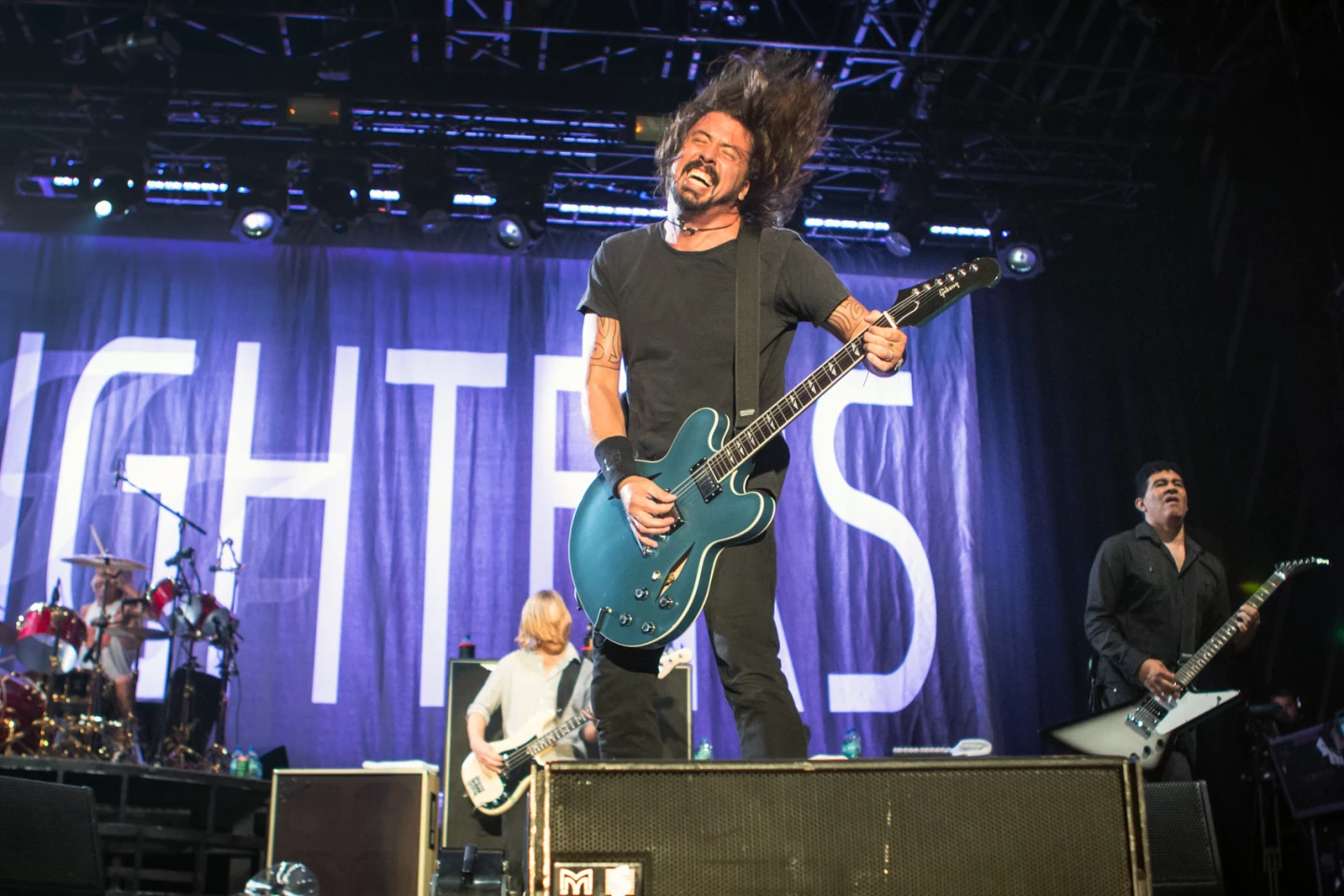
GeoNet doesn’t provide a comparable earthquake magnitude for the vibrations, but the Seismology Research Center says that “vibrations of engineering significance” occur at frequencies between less than 0.2 Hz and 20 Hz. GeoNet did, however, attribute the tremors to the weight of fans dancing based on actual math: 50,000 fans are equal to around 5,000 tonnes (5,512 US tons) of mass moving – or moshing – on the ground. They also said that the sound system probably contributed, especially bass frequencies.
“Swift Quake” Part 2: The LA Quake Study
This brings us to new research by the Seismological Society of America (SSA), published in Seismological Research Letters.
In the wake of the July “Swift Quake” in Seattle, researchers examined the seismic signals produced by an ‘Eras’ show at LA’s SoFi Stadium on the 5th of August, 2023. Analyzing spectrograms – graphs that display the strength of various signal frequencies over time – of the concert, they calculated the radiated energy of each of Swift’s songs and interpreted that number in terms of the local magnitude of an earthquake that would’ve radiated the same energy. Songs varied considerably in magnitude, with “Shake It Off” coming out on top with a local magnitude of 0.851.
“Keep in mind this energy was released over a few minutes compared to a second for an earthquake of that size,” said lead author Gabrielle Tepp from the Seismological Laboratory at Caltech. “Based on the maximum strength of shaking, the strongest tremor was equivalent to a magnitude 2 earthquake.”

The researchers concluded that the harmonic tremor observed was likely generated by 70,000 Swifties dancing and jumping, not the musical beats or reverberations of the sound system. Distinct from the discrete seismic shocks associated with earthquakes, harmonic tremor is a continuous low-frequency ground vibration caused by magma movement. Large music festivals and stadium concerts are known to produce unique vibration signals that resemble harmonic tremor, particularly at frequencies around 1-10 Hz.
Pulling data from the regional seismic network stations to examine the tremors created by other musicians who’d played at SoFi Stadium, the researchers found that some of the most interesting data came from the Metallica concert, which “had the weakest signals in terms of the strongest magnitude from each concert,” Tepp said.
“Metal fans like to headbang a lot, so they’re not necessarily bouncing,” Tepp added. “It might just be that the ways in which they move don’t create as strong of a signal.”
Apologies to the head-bangers.
So, whose fans won?
This is going to bruise some rock egos, but based on the magnitude, compared to her musical rivals, Tay and her incredibly enthusiastic Swifties are the clear winners here with their 2.3-magnitude earth-mover. The people at Guinness agree and have awarded Swift a World Record for greatest seismic activity caused by a music concert.
And AC/DC receive an Honorable Mention from us, based purely on volume.
